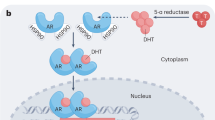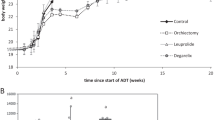Abstract
We investigated whether the combination of chlormadinone acetate (CMA) and a luteinizing hormone releasing hormone (LH-RH) agonist, leuprorelin acetate (leuprorelin), more markedly decreased ventral prostate and seminal vesicle weights and plasma sex hormone levels in male rats. Four weeks after administration of 0.28, 0.84 or 2.8 mg/kg of leuprorelin, ventral prostate weights significantly decreased (53.8, 54.4 and 64.1%) and the plasma testosterone levels significantly lowered, but not dose-dependently. After repetitive administrations of 3 and 30 mg/kg/day of CMA, the rates of ventral prostatic atrophy were 37.1 and 65.9%, respectively. Although there was no change in the plasma testosterone level at 3 mg/kg, 30 mg/kg of CMA significantly decreased the level. A combination of leuprorelin (0.28 mg/kg) and CMA (3 or 30 mg/kg) more potently induced ventral prostatic and seminal vesicle atrophy than leuprorelin alone. Furthermore, a combination of leuprorelin and CMA (30 mg/kg) more markedly decreased the plasma testosterone level. According to the pharmacokinetic data for CMA in male rats, the doses of CMA correspond to the clinical dose. These findings suggest that combination therapy with an LH-RH agonist and CMA is more useful than therapy with the agonist alone in the treatment of prostate cancer.
This is a preview of subscription content, access via your institution
Access options
Subscribe to this journal
Receive 4 print issues and online access
$259.00 per year
only $64.75 per issue
Buy this article
- Purchase on Springer Link
- Instant access to full article PDF
Prices may be subject to local taxes which are calculated during checkout







Similar content being viewed by others

References
Smith JA Jr, Glode LM, Wettluafer JN, Stein BS, Glass AG, Max DT, Anbar D, Jagst CL, Murphy GP . Clinical effects of gonadotropin-releasing hormone analogue in metastatic carcinoma of prostate. Urology 1985; 25: 106–114.
Akaza H, Isaka S, Usami M, Kanetake H, Kotake T, Koiso K, Aso Y . Recommended dose of flutamide with LH-RH agonist therapy in patients with advanced prostate cancer. Int J Urol 1996; 3: 468–471.
Denis LJ, Keuppens F, Smith PH, Whelan P, de Moura JL, Newling D, Bono A, Sylvester R . Maximum androgen blockade: final analysis of EORTC phase III trial 30853. Eur Urol 1998; 33: 144–151.
Akaza H, Homma Y, Okada K, Yokoyama M, Moriyama N, Usami M, Hirao Y, Tsushima T, Ohashi Y, Aso Y . Early results of LH-RH agonist treatment with or without chlormadinone acetate for hormone therapy of naive localized or locally advanced prostate cancer: a prospective and randomized study. Jpn J Clin Oncol 2000; 30: 131–136.
Crawford ED, Eisenberger MA, McLeod DG, Spaulding JT, Benson R, Dorr FA, Blumenstein BA, Davis MA, Goodman PJ . A controlled trial of leuprolide with and without flutamide in prostatic carcinoma. New Engl J Med 1989; 321: 419–424.
Fourcade RO, Chatelain C . Androgen deprivation for prostatic carcinoma: a rationale for choosing components. Int J Urol 1998; 5: 303–311.
Schellhammer PF, Sharifi R, Block NL, Soloway MS, Venner PM, Patterson AL, Sarosdy MF, Vogelzang NJ, Schellenger JJ, Kolvenbag GJ . Clinical benefits of bicalutamide compared with flutamide in combined androgen blockade for patients with advanced prostatic carcinoma: final report of a double-blind, randomized, multicenter trial. Urology 1997; 50: 330–336.
Debruyne FMJ, Akaza H, Fitzpatrick JM, Mahler C, Motta M, Thrasher JB, Tunn UW, Varkarakis M, van der Poel HG . Secondary hormonal therapy in prostate cancer. In: Murphy G, Khoury S, Partin A, Denis L (eds). Prostate Cancer. Health Publication Ltd: Paris1999. pp. 395–407.
Shibata Y, Ito K, Suzuki K, Nakano K, Fukabori Y, Suzuki R, Kawabe Y, Honma S, Yamanaka H . Changes in the endocrine environment of the human prostate transition zone with aging: simultaneous quantitative analysis of prostatic sex steroids and comparison with human prostatic histological composition. Prostate 2000; 42: 45–55.
Labrie F, Belanger A, Simard J, Labrie C, Dupont A . Combination therapy for prostate cancer. Cancer 1993; 71: 1059–1067.
Bélanger B, Bélanger A, Labrie F, Dupont A, Cusan L, Monfette G . Comparison of residual C-19 steroids in plasma and prostatic tissue of human, rat and guinea pig after castration: unique importance of extratesticular androgens in men. J Steroid Biochem 1989; 32: 695–698.
Oefelein MG, Cornum R . Failure to achieve castrate levels of testosterone during luteinizing hormone releasing hormone agonist therapy: the case for monitoring serum testosterone and a treatment decision algorithm. J Urol 2000; 164: 726–729.
Okada H, Heya T, Igari Y, Ogawa Y, Toguchi H, Shimamoto T . One-month release injectable microspheres of leuprolide acetate inhibit steroidogenesis and genital organ growth in rats. Int J Pharm 1989; 54: 231–239.
Kinoshita Y, Nishimura R, Hosaka M . A phase I study of TZP-61: single oral adminstration (1). Jpn Pharmacol Ther 1988; 16: 2079–2091.
Skinner DC, Evans NP, Delaleu B, Goodman RL, Bouchard P, Caraty A . The negative feedback actions of progesterone on gonadotropin-releasing hormone secretion are transduced by the classical progesterone receptor. Proc Natl Acad Sci USA 1998; 95: 10978–10983.
Yoshida K, Takeuchi S . Pretreatment with chlormadinone acetate eliminates testosterone surge induced by a luteinizing-hormone-releasing hormone analogue and the risk of disease flare in patients with metastatic carcinoma of the prostate. Eur Urol 1995; 27: 187–191.
Shimada M, Uchida H, Kasahara T, Fuji K, Ogawa Y, Yoshida H, Hamajima T, Matsuda N, Ikeuchi T, Kai Y, Hiramori M, Hoshino M, Inoue K, Higaki Y . Clinical study on chlormadinone acetate alone followed by combination with LH-RH analogue for prostatic cancer: effects on lipid metabolism. Acta Urol Jpn 1998; 44: 525–532.
Yamamoto A, Sumiyoshi Y, Miyake N, Yokozeki H, Kanayama H, Kagawa S . Pretreatment with chlormadinone acetate in prostate cancer patients treated with a luteinizing hormone-releasing hormone analogue. Acta Urol Jpn 1998; 44: 557–563.
Author information
Authors and Affiliations
Rights and permissions
About this article
Cite this article
Gotanda, K., Shinbo, A., Okada, M. et al. Effects of combination therapy with a luteinizing hormone-releasing hormone agonist and chlormadinone acetate on rat prostate weight and plasma testosterone levels. Prostate Cancer Prostatic Dis 6, 66–72 (2003). https://doi.org/10.1038/sj.pcan.4500617
Received:
Revised:
Published:
Issue Date:
DOI: https://doi.org/10.1038/sj.pcan.4500617


